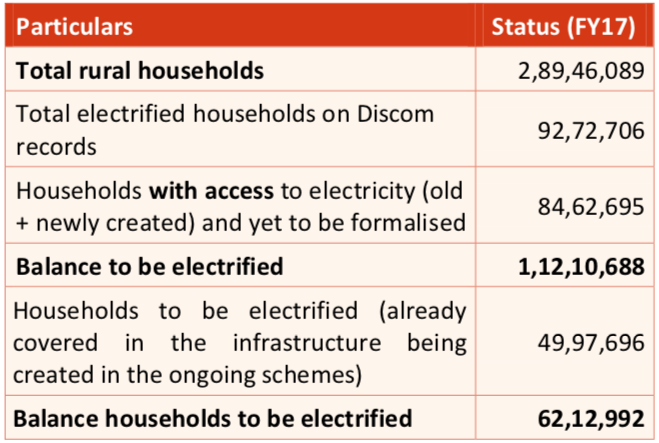A rare window is open for power sector reform in Uttar Pradesh. The Bharatiya Janata Party (BJP), in office in both Lucknow and New Delhi, has a sweeping mandate to transform Uttar Pradesh’s troubled electricity situation. The party has made two important commitments on this front. First, to ensure every household in the state has an electricity connection and access to 24-hour reliable supply. Second, to turn around the state’s five loss-making public distribution companies, or discoms.
Progress in both areas is sorely needed. In 2017, more than 17 million rural households did not have a formal electricity connection. Supply remains unreliable in urban and rural areas, hampering economic growth.
Since the 1980s, the state’s public discoms have been accruing annual losses, the result of a large gap between the cost of supplying electricity and the revenue they recover from customers, coupled with underfunded subsidised tariffs for domestic and agricultural users.
The former Samajwadi Party government signed Uttar Pradesh up to the central government’s UDAY power sector reform scheme in 2016. This allowed 75 percent of discom debts to be cleared, and various initiatives to improve the companies’ financial performance were started. But discoms are continuing to report sizable losses.

Source: Government of India and Government of Uttar Pradesh. (2017). 24×7 Power for All Uttar Pradesh
Universal electricity access and discom performance are closely intertwined challenges in Uttar Pradesh. Increasing access and reliability of supply ultimately will depend on success in transforming the performance of discoms—in particular reducing the large losses they accrue in supplying domestic and agricultural consumers. Put simply, it will not be possible to provide reliable electricity to millions of additional rural households as long as discoms face high losses supplying rural and agricultural users.
Successive governments since the 1990s have in practice focused on access, without coupling this with serious action on improving discoms’ performance. Politics explains this. Decisive programs for household electrification and increasing the hours of supply are politically popular in the short term. Tackling the state’s loss-making discoms, in contrast, requires political parties in office to allow electricity tariffs for domestic and agricultural consumers to rise regularly, and to take stringent action on revenue collection and theft. In a politically competitive multiparty state, no party has been willing to make the bargain of jointly tackling both areas, for fear of electoral repercussions.
Challenges exist besides highly subsidised tariffs, high theft levels, and poor revenue recovery for Uttar Pradesh’s discoms. While many states can rely on industry consumers to pay high tariffs that cross-subsidise low tariffs for other users, Uttar Pradesh has only a small base of industrial consumers. Additionally, the cost at which discoms receive power from generators is high.
On household electrification and reliability of supply, the BJP has moved fast. Progress is already evident. By way of the central government’s Saubhagya scheme, millions of households have been provided with a regularised electricity connection, and millions more will be connected in the coming two years.
Although the BJP’s target of full household electrification by 2019 looks difficult, the goal may be reached soon thereafter. The BJP has drawn up a 24X7 Power For All plan for Uttar Pradesh, which promises 24-hour electricity supply to all rural and urban domestic and industrial consumers from late 2018. Currently, rural areas receive around 18 hours’ supply. This in itself represents a notable improvement above the supply situation of recent years.
Toward reforming the financial performance of the state’s discom, the BJP is also acting on various fronts. It has built upon programmes the previous Samajwadi Party government started to extend metering, improve billing and revenue collection, and cut down on theft. The BJP has expended significant political capital by pushing through substantial increases in electricity tariffs for domestic and agricultural users, helping to bring down the gap between cost of supply and revenue collected. However, losses at the state’s discoms remain high. With elections due in 2019, the BJP may find it politically unpalatable to take further steps to raise tariffs and cut down on losses in the coming year.
Electoral support has for decades been mobilised on the basis of promises of cheap or free electricity in Uttar Pradesh. In the 1970s and 1980s, farmers were promised cheap electricity. In the 2000s, it was weavers who were wooed with subsidised power. Losses are typically significantly higher in VIP districts.
A window of opportunity to change the status quo is open in Uttar Pradesh. If the BJP can deliver on reliable access for all, and link success on this front to public acceptance of regular tariff increases and timely bill payment, then the seeds of transformation in the power sector may be sown.
When the BJP last ruled in both Lucknow and New Delhi, between 1997 and 2002, the party pushed through extensive structural reforms of the power sector, against significant opposition. However, shortly after doing so, it backtracked on tariff increases required by the state’s discoms to support a financial turnaround, fearing electoral defeat. It remains to be seen whether a story of bold ambitions from the BJP giving way to electoral pressures is repeated.
Jonathan Balls is a New Generation Network postdoctoral scholar at the Australia India Institute, The University of Melbourne. This research is based on work presented in full in the book Mapping Power: The Political Economy of Electricity in India’s States, edited by Navroz K. Dubash, Sunila Kale, and Ranjit Bharvirkar.
A version of this blog post first appeared in the Hindustan Times.
